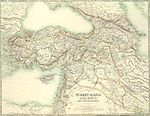Anatolian beyliks
This article needs additional citations for verification. (June 2010) |

Anatolian beyliks (
One of the beyliks, that of the
The word beylik denotes a territory under the jurisdiction of a bey, equivalent to a duchy or principality in other parts of Europe.[1]
History

Following the 1071
However,
As the
By 1300, the Turks had reached the
Under its eponymous founder,
But the Ottoman state quickly collected itself under
List of beyliks
Beyliks founded after Manzikert (1071)
In the list below, only the beyliks that were founded immediately after the Battle of Manzikert in 1071, mostly situated towards eastern Anatolia, and who were vassals (or sometimes at war) of the centralized power of the Seljuk Sultanate of Rum based in Konya are listed.

| Beylik's name | Capital city | Duration of rule |
|---|---|---|
| Beylik of Smyrna | İzmir | 1081–1098 |
| Shah-Armens (also called Ahlatshahs) | Ahlat | 1110–1207 |
| Artuqids (three branches) | Harput
|
1102–1409 |
Danishmend
|
Sivas | 1071–1178 |
| Dilmaçoğlu | Bitlis | 1085–1398 |
İnaloğlu
|
Diyarbekir
|
1095–1183 |
Mengujekids
|
Erzincan, later Divriği | 1072–1277 |
| Saltukids | Erzurum | 1072–1202 |
| Çubukoğulları | Harput
|
1085–1112 |
| Beylik of Tanrıbermiş | Alaşehir | 1071–1098 |
Beyliks founded after Köse Dağ (1243)
A second group beyliks emerged as a result of the weakening of this central state under the
| Beylik's name | Capital city | Duration of rule |
|---|---|---|
Ahiler[6]
|
Ankara | c. 1290–1362 |
| Alaiye | Alanya | 1293–1471 as vassals to Karamanids |
| Aydinids | Ayasluğ (Selçuk )
|
1300–1425 |
| Canik | Samsun, Amasya and the vicinity | ?–1460 |
| Candar (later also known as Beylik of Isfendiyar) | Eflani, later Kastamonu, last Sinop | 1291–1461 |
| Chobanids | Kastamonu (preceding the Candars) | 1211–1309 |
Dulkadirids
|
Elbistan, later Maraş | 1348–1522 |
Eretnids
|
Sivas, later Kayseri | 1335–1390 |
Erzincan
|
Erzincan | 1379–1410 |
| Eshrefids | Beyşehir | 1285–1326 |
| Germiyanids | Kütahya | 1300–1429 |
| Hamidids | Eğirdir | 1300–1391 |
| Kadi Burhan al-Din | Eretnids )
|
1381–1398 |
| Karamanids | Larende (Karaman )
|
1250–1487 |
Karası
|
Balıkesir, later Bergama and Çanakkale | 1296–1357 |
Inanjids , subordinate to Sahib Ataids and Germiyanids)
|
Denizli | 1262–1391 |
Menteşe
|
Milas | 1261–1424 |
| Ottomanids (later the Ottoman Empire) | 1299–1922 | |
| Pervâneid | Sinop | 1277–1322 |
| Ramadanids | Adana | 1352–1608 |
| Sahib Ataids | Afyonkarahisar | 1275–1341 |
| Sarukhanids | Manisa | 1300–1410 |
| Teke (issued from the Hamidids) | Antalya, later Korkuteli | 1321–1423 |
Society
Language
Combined with the Seljuks and the migration of Turkic tribes into the Anatolian mainland, the Anatolian beyliks spread the Turkic language and Islamic culture in Anatolia.[7] Unlike the Seljuks, whose administrative language was Persian, the Anatolian beyliks adopted spoken Turkic as their formal literary language.[7] The Turkish language thus achieved widespread use in these principalities and reached its highest sophistication during the Ottoman era.[7]
Art
In spite of their limited sources and the political climate of their era, art during the Anatolian beyliks flourished, probably forming the basis for
Some representative examples of the Anatolian beyliks' architecture are
Architecture
- Ulucami Mosque in Ermenek (1302)
- Ulucami Mosque in Manisa (1374)
- İsabey Mosque at Selçuk(1375)
- Hatuniye Madrassa in Karaman (1382)
- İlyas Mosque at Balat (Milet) (1404)
- Akmedrese Madrassa in Niğde (1409)
See also
| History of Turkey |
|---|
 |
| Timeline |
|
|
References
- ISBN 90-6831-799-7.
- ^ "The Cresques Project - Panel IV". www.cresquesproject.net.
- ISBN 978-90-474-2497-0.
- ISBN 978-1597404761
- ISBN 0-521-64221-3.
- Ahilerfor more information.
- ^ a b c Encyclopedia of the Ottoman Empire, Gábor Ágoston, Bruce Alan Masters, page 40
Sources
- Westermann Großer Atlas zur Weltgeschichte (in German)
External links
- "Osmanlı Medeniyeti (Ottoman Civilization)" (in Turkish). Archived from the original on 2005-08-01. Retrieved 2005-07-18.

